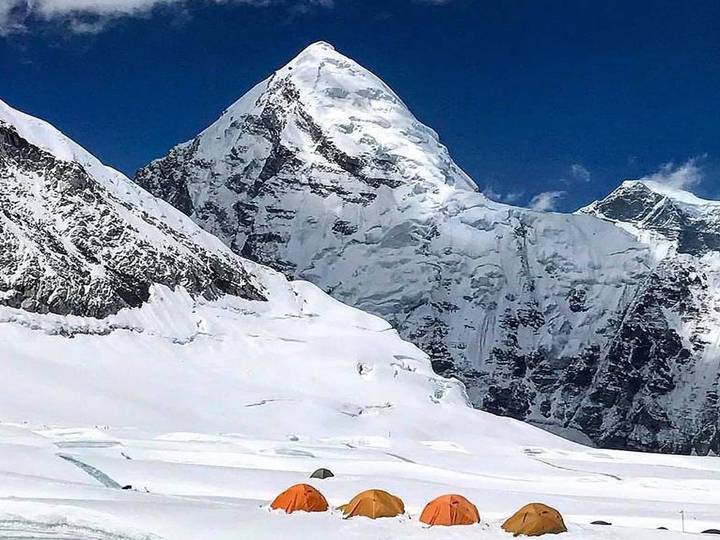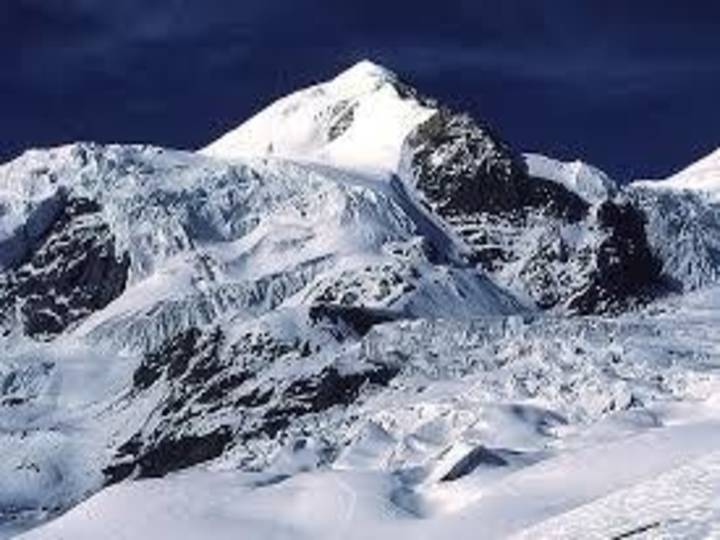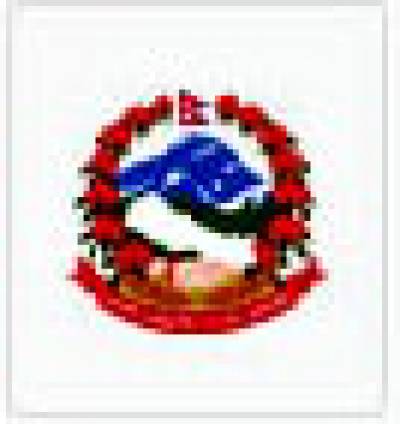PUMORI EXPEDITION
Only eight kilometers from Mt. Everest! The Pumori Expedition awaits the climbing enthusiast and adventurer. Go for it! One of the more difficult 7000m peaks.
Mt. Pumori (7161m/27,494ft) will test your endurance and climbing skills, but like all mountains, the rewards will overwhelmingly compensate for the effort required to reach its summit. Mt. Pumori is located on the border of Nepal in the Mahalangur Himal in the Himalayas, stretching from Nangpa La Pass between Rolwaling Himal and Cho Oyu, to the Arun River. It includes Mount Everest, Lhotse, Makalu, and Cho Oyu — four of earth's six highest peaks. Pumori means "the Mountain Daughter" in the Sherpa language. ‘Pumo’ means young girl or daughter and ‘Ri’ means mountain.
This expedition requires you to have previous climbing experience and are familiar with the use of ropes and other mountaineering equipment. You will climb across glaciers and snow-covered ridges to reach the summit. This is not something for the faint-hearted! This is a genuine climbing expedition that requires climbing up 40 to 60-degree slopes. Fortunately, you will be roped-off and will have some expert guidance before and during the climb. Several camps will be established at varying altitudes prior to ascending to the summit.
The main attraction of climbing Mt. Pumori is that it offers fantastic views of Mt. Everest and views toward Tibet and the Rongbuk Glacier. It is also used as preparation for climbing Mt.Everest.
From Gorakshep we begin the climbing period. Before we head to the summit we will be well and truly ready for the challenge ahead. We will practice daily numerous climbing skills and take short climbs to higher elevations to give you confidence and an opportunity to test your skills. Your Sherpa Expedition & Trekking guide will check, and double check, all equipment and be sure that everyone is mentally and physically well enough to attempt the climb to Pumori Summit (7160m). We have scheduled a few days in the event the weather is unsuitable for climbing. These days are not wasted and will further help you to acclimatize as we camp at several altitudes on the side of the mountain as designated base camps. We will make an early morning start on the day of the climb, allowing ample time to reach the summit. Morning weather is often calmer and more predictable, but we mustn’t forget that “mother nature” makes its own rules.
We will ascend the south-east ridge, reaching here by following the trail through the Khumbu region, passing through Phakding (2652m), Namche Bazaar (3440m), Everest View Hotel (3800m), Tyangboche (3850m) with time to explore its well known Buddhist monastery before reaching Dingboche (4350m) and further on Lobuche (5018m) where we take time out to acclimatize, something critical to your physical well-being that could determine your ultimate success in climbing Mt. Pumori. We then head to Gorakshep (5170m). You will notice the gradual ascent to higher altitudes. Some believe the ultimate daily increment of 500 meters best assists the acclimatization process.
Base Camp is at (5300m/17,388ft). The next camp requires crossing icy masses and sharp ridge for 4 to 5 hours before arriving at Camp I (5700m/18,701ft). From camp I, we ascend a 40 to 60-degree face through the snow before arriving at Camp II (6200m/20,341ft). From camp II we cross more ice and chasms before reaching Camp III (6500m/21,325ft). Camp III is the launch point to reach the summit.
Your biggest obstacle in reaching the summit will be altitude sickness and lack of mental and physical will power.
Sherpa Expedition and Trekking use Sherpa guides (well known for their climbing skills) to lead you safely to the summit.
ITINERARY
Day 1 : Arrival in Kathmandu and Transfer to hotel.
Day 2 : Preparation, briefings, shopping and formalities for permit.
Day 3 : Fly to Lukla and Trek to Phakding (2652m-4 Hrs.)
Day 4 : Trek to Namche Bazaar (3440m-6 Hrs.)
Day 5 : Rest & acclimatization, explore Everest View Hotel (3800m-3 Hrs.).
Day 6 : Trek to Tyangboche (3850m-5 Hrs.); Explore Buddhist monastery
Day 7 : Trek to Dingboche (4350m-5Hrs.)
Day 8 : Trek to Lobuche (5018m-4Hrs.)
Day 9 : Rest for acclimatization at Lobuche.
Day 10 : Trek to Gorakshep (5170m-3 Hrs.)
Day 11 - 28 : Climbing period Summit Pumori (7, 161m), full camping.
Day 29 : Down trek to Gorakshep, overnight lodge.
Day 30 : Trek via Lobuche (5218m)to Dingboche(4260m-5 Hrs.)
Day 31 : Trek to Tyangboche (3860m-5 Hrs.), lodge.
Day 32 : Trek to Namche Bazaar (3440m-4 Hrs.)
Day 33 : Trek to Lukla (2840m-7 Hrs.)
Day 34 : Fly from Lukla to Kathmandu; hotel transfer, debriefing.
Day 35 : Contingency day in Kathmandu, farewell celebration dinner.
Day 36 : Transfer to the airport for final departure, end of the trip.
SERVICES
Full Board Service Included
- Airport transportation as per your arrival date to join the Pumori expedition
- 3-star category hotel accommodation in Kathmandu on B/B plan
- Kathmandu to Lukla to Kathmandu airfare as per the expedition itinerary.
- Pumori summiteers climbing Sherpa (01 Sherpa: 02 climber’s ratio)
- Group climbing gears like rope, ice bar, etc for the Pumori expedition.
- Pumori peak climbing permit and all government taxes.
- National park and conservation area permit fee for the expedition.
- Full board high altitude meal while trekking to base camp and climbing Pumori
- Liaison officer with all his expenses while on the Pumori climbing expedition.
- Expedition Manager, Expedition cook, support crew and porters with their types of equipment, daily wages, food, insurance, etc.
- All camping gear including base camp tents, dining tent with table and chair, kitchen and toilet tent, etc
- Mountain Hardware high altitude tents while climbing the Pumori expedition
- Emergency Oxygen with regulator and mask while on the Pumori expedition.
- EPI gas and burner for the high climb.
- Gamow bag / Portable Altitude Chamber (PAC) All necessary climbing hardware group equipment
- Satellite Phone and Walkie-Talkie in case of emergency.
Cost Excludes
- Medical and personal high-risk insurance
- Nepal entry visa fee (easy to obtain the visa on arrival at Tribhuvan International Airport – Kathmandu). $30 USD for 15-day, $50 USD for 30 Days, and $125 USD for 90 Days visa.
- The main meal in Kathmandu
- Personal equipment and climbing gears.
- International airfare and airport tax
- Climbing Bonus, tips and personal nature expenses.
- Applicable permit fees and custom charge for Sat phone, communication equipment and commercial filming while on Pumori expedition.
EQUIPMENTS
Travel Documents
- Valid Passport
- Credit Cards
- Pp Size Photo (4 Pieces)
- Insurance Paper And Contact Address.
- Family Members / Company’s Contact Address
Foot Wear
- Kailas / Lasportiva / Millet (Summit Shoe)
- Normal Socks (5-6 Pairs)
- Summit Socks (2 Pairs)
- Trekking Shoes (1 Pair)
- Camp Booties (1 Pair)
- Basecamp Slipper (1 Pair)
Upper Body
- Light Weight Top / Thermo Coat (2-3 Layers)
- Mid Weight Top (2-3 Layers)
- Heavy Weight Top (2 Layers)
- Fleece Jacket (1)
- Gore Text Jacket (1)
- Down Jacket (1)
- Wind Proof Jacket
- Cotton T-Shirt For Base Camp. (2-3)
Lower Body
- Light Weight Long Under Pants (2-3 Pairs)
- Under Wear (5-7 Pairs)
- Mid Weight Long Under Pants (2-3 Pairs)
- Heavy Weight Long Under Wear
- Gore Text Pant. (1)
- Down Pants. (1)
- Water Proof Pant. (1)
Head
- Sun Cap
- Desert Cap
- Balaclava
- Fleece Hat
- Neck Gaiter (2-3)
Hands
- Thin Fleece Gloves (2 Pairs)
- Wind Stopper Fleece Gloves
- Heavy Gloves (Mitten)
- Summit Gloves
Sleeping Bags
- Sleeping Bag - 20 Degree Celsius (For Base Camp)
- Down Sleeping Bag - 20 To -40 Degree Celsius (Extreme Comfort)
- Thermarest Mattress (Cell Foam)
- Thermarest Mattress (Inflatable)
Climbing Equipment
- Climbing Helmet
- Down Suit (Kailas / Marmot / Mountain
- Hardware / North Face / Millet )
- Crampons (Fit with Boot)
- Ice Axe
- Harness
- Atc Guide
- Jummer / Ascender
- Lock Carabiner (3)
- Unlock Carabiner (3)
- Tape Slings (2)
- Prusik Loops (1)
- Snow Goggle
- Head Light (4 Pairs Rechargeable Batteries Recommended)
- Satellite Phone
- Hand Warmer (If Possible)
Bag Packs
- Rucksacks 45L - 55L
- Duffle Bag 90 L -120 L (2 Pieces)
- Water Proof Stuff Sacks Large (2 Pieces)
- Water Proof Stuff Sacks Small (2 Pieces)
Sun Stuffs
- Banana Boat/ Nivea Sun Cream -50 (Spf)
- Lip Guard -20 / -50 (Spf)
- Sun Glasses (UV Protection)
- Glaciers Glasses (UV Protection)
Toiletries
- Hand Disinfectant
- Wet Tissue
- Toothpaste
- Toothbrush
- Soap
- Shampoo
- Garbage Bag
Eating & Drinking
- Water Bottle (2)
- Thermos
- Mug
- Spoon/ Fork
- Bowl
Medical
- Brufen / Ibuprofens
- Antibiotic
- Diamox
- Paracetamol
- Handy Plaster
- Crack Bandage
- Tincture Iodine
Miscellaneous
- Walking Stick
- Pocket Knife (Swiss)
- Umbrella / Rain Coat
GOOD TO KNOW
The Pumari Expedition is a challenging and rewarding mountaineering adventure in the Himalayas of Nepal. Standing at an impressive height of 7,161 meters (23,494 feet), Pumari offers breathtaking views and an exhilarating climbing experience. Here are all the important details you need to know before embarking on a Pumari Expedition:
1. Location: Pumari is located in the Mahalangur Himal range of Nepal, within the Sagarmatha National Park. It is situated near the iconic Everest region, offering stunning views of Everest, Lhotse, and other surrounding peaks.
2. Technical Difficulty: Pumari is considered a technically challenging peak, requiring climbers to have prior mountaineering experience. It involves steep slopes, icy sections, crevasses, and some technical climbing skills. Climbers should be proficient in using crampons, ice axes, and other mountaineering equipment.
3. Physical Fitness: Excellent physical fitness is crucial for a successful Pumari Expedition. Climbers should have a high level of stamina, endurance, and strength to handle the demanding climb. Regular cardio and strength training exercises, as well as acclimatization hikes, are recommended to prepare for the expedition.
4. Duration: The duration of the Pumari Expedition varies depending on several factors, including weather conditions and climbers' acclimatization. On average, it takes around 30-35 days to complete the expedition, including trekking to the base camp, acclimatization periods, and the summit climb.
5. Climbing Permit: A climbing permit is required to climb Pumari. Climbers need to obtain a permit from the Nepal Governments or through a registered trekking agency. It is important to ensure all necessary permits are obtained before starting the expedition.
6. Guides and Sherpas: It is highly recommended to hire experienced local guides and Sherpas for the Pumari Expedition. They have extensive knowledge of the region, weather conditions, and mountaineering techniques. They can provide valuable assistance, ensure safety, and enhance the overall experience.
7. Accommodation: During the expedition, climbers usually stay in tented camps. It is advisable to bring a good quality sleeping bag and other necessary camping equipment. Basic teahouses may be available in some lower-altitude areas during the trek to the base camp.
8. Weather Conditions: Weather plays a crucial role in the success of the Pumari Expedition. The best time to attempt the climb is during the pre-monsoon season (March to May) and post-monsoon season (September to November). These months offer stable weather conditions and clear visibility.
9. Safety Precautions: Safety should always be a top priority during the expedition. Climbers should have proper acclimatization, follow the guidance of experienced guides, and be prepared for any emergencies. It is essential to carry essential safety equipment, such as a first aid kit, communication devices, and oxygen cylinders.
10. Environmental Considerations: As responsible climbers, it is important to practice Leave No Trace principles and respect the environment. Carry all waste back with you, avoid damaging vegetation, and be mindful of the local culture and customs.
Embarking on a Pumari Expedition is a challenging and rewarding experience. It requires careful planning, physical preparation, and the right mindset. With the right guidance and preparation, climbers can conquer the majestic Pumari and create memories to last a lifetime.
MAP
PHOTOS/Videos
Departures
Select a departure month
Fill out the form below and a Travel Expert will reach out to create your perfect tour.
FAQS
Where is Pumari located?
Pumari is located in the Mahalangur Himal range of Nepal, within the Sagarmatha National Park. It is situated near the Everest region.
How high is Pumari?
Pumari stands at an elevation of 7,161 meters (23,494 feet) above sea level.
Is previous climbing experience required to climb Pumari?
Yes, previous climbing experience is required to climb Pumari. It is considered a technically challenging peak and climbers should have prior experience in mountaineering, including knowledge of roped glacier travel, ice climbing, and the use of climbing equipment.
What is the best time to climb Pumari?
The best time to climb Pumari is during the pre-monsoon season (March to May) and post-monsoon season (September to November). These months offer stable weather conditions and clear visibility, making it ideal for climbing.
How long does it take to climb Pumari?
The duration of the Pumari Expedition can vary depending on various factors such as climbers' fitness level, acclimatization, and weather conditions. On average, it takes around 30-35 days to complete the expedition, including trekking to the base camp, acclimatization periods, and the summit climb.
Is a climbing permit required to climb Pumari?
Yes, a climbing permit is required to climb Pumari. Climbers need to obtain a permit from the Nepal Governments or through a registered trekking agency. It is important to obtain the necessary permits before starting the expedition.
Are there any technical difficulties involved in climbing Pumari?
Yes, climbing Pumari involves technical difficulties such as steep slopes, icy sections, crevasses, and some technical climbing skills. Climbers should be proficient in using mountaineering equipment like crampons, ice axes, and ropes.
Is it necessary to hire a guide or Sherpa for the Pumari Expedition?
While it is not mandatory, it is highly recommended to hire experienced local guides and Sherpas for the Pumari Expedition. They have extensive knowledge of the region, weather conditions, and mountaineering techniques. They can provide valuable assistance, ensure safety, and enhance the overall experience.
What kind of physical fitness is required to climb Pumari?
Climbing Pumari requires excellent physical fitness. Climbers should have a high level of stamina, endurance, and strength to handle the demanding climb. Regular cardio and strength training exercises, as well as acclimatization hikes, are recommended to prepare for the expedition.
What are the accommodation options during the Pumari Expedition?
During the expedition, climbers usually stay in tented camps. It is advisable to bring a good quality sleeping bag and other necessary camping equipment. Basic teahouses may be available in some lower-altitude areas during the trek to the base camp.
Latest Traveller’s Reviews
Travel experiences of our clients who recently returned from their trips.
100%
Based On 4 Reviews
Jessie Rayne
Australia
November 8, 2023
Immersed in the majesty of the Khumbu region
The Pumori Expedition takes you deep into the heart of the Khumbu region, immersing you in its majestic beauty. You'll traverse through picturesque valleys, cross icy glaciers, and witness the grandeur of towering peaks. It's a chance to experience the unique charm and culture of the Sherpa people while surrounded by nature's wonders.
Eila Jokinen
France
November 1, 2023
A challenge worth conquering
The Pumori Expedition is a challenge worth conquering for experienced mountaineers. With its technical sections and steep ascents, it tests your physical and mental strength. However, the sense of accomplishment and the stunning views from the summit make it all worthwhile. It's an adventure that pushes you to your limits and rewards you with unforgettable memories.
Kevin Schroeder
United Kingdom
June 28, 2023
An exhilarating climb with breathtaking views
The Pumori Expedition offers an exhilarating climb with breathtaking views that will leave you in awe. From the base camp to the summit, every step of the journey is filled with awe-inspiring landscapes and panoramic vistas of the Himalayan range. It's a true mountaineering adventure that will take your breath away.
People Considering This Package Right Now Check availability
























